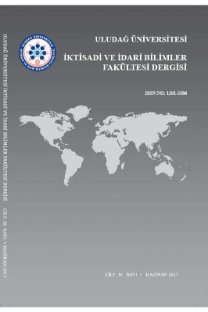The Models of Exchange Rate Determination
1970'li yıllarda esnek fiyat para modeli, yapışkan fiyat para modeli ve portföy denge modeli olmak üzere üç model geliştirildi. Bu modellerin amaci özellikle esnek döviz kuru sistemi kabul edildikten sonraki dönemde, döviz kurlarındaki dalgalanmaları açıklamaktı. Yapılan ampirik çalışmaların sonuçları, genellikle bu modellerin tahminlerini desteklemiyordu. Bu makalenin amacı belirtilen modelleri teorik açıdan incelemek ve modellerle ilgili yapılan ampirik çalışmaların döviz kurlarında gözlenen dalgalanmaları açıklamakta ne kadar başarılı olduklarını belirlemektir.
During 1970s, three competing theories of exchange rate determination were developed: the flexible price monetary model, the sticky price monetary model, and the portfolio balance model. The aim of these models has been to give a plausible explanation to volatility in exchange rates, especially after the adoption of the flexible exchange rate system. The empirical findings of the models have not been supportive of the predictions of the models. The purpose of this paper is to analyze these theoretical models in a detailed form to evaluate whether they have been adequate in explaining volatility in exchange rates.
___
Backus, D. (1984), "Empirical Models of the Exchange Rate: separating the wheat from the chaff," Canadian Journal of Economics, vol. 17, no. 4.Baxter, M. (1994), "Real Exchange Rates and Real Interest Differentials," Journal of Monetary Economics, vol. 33, pp. 5-37.
Bilson, F.O.J. (1978), "Rational Expectations and the Exchange Rate," in the Economics of Exchange Rates: Selected Studies. Eds: Jacob A. Frenkel and Harry G. Johnson, Addison Wesley Publishing Company, pp. 75-96.
Branson, W. H., Halttunen, H., and Masson, P. (1977), "Exchange Rates in the Short-run: The Dollar-Deutschemark Rate," European Economic Review, vol. 10, pp. 303-324.
Branson, W. H. and Hendersen D. W., (1985), "The Specification and Influence of Asset Markets," in Handbook of International Economics, vol. II. Eds: Ronald W. Jones and Peter B. Kenen. Netherlands: Elsevier Science Publishers, pp. 750-802.
Dornbusch, R. (1980), "Exchange Rate Economics: Where Do We Stand?" Brookings Papers on Economic Activity, no. 1, pp. 145-185.
Dornbusch, R. and Fischer, S. (1980), "Exchange Rates and the Current Account," American Economic Review, vol. 70, pp. 960-971.
Driskill, R.A. (1981), "Exchange Rate Dynamics: An Empirical Investigation," Journal of Political Economy, vol. 89, no. 21, pp. 357-371.
Frankel, J. A. (1979), "On the Mark: A Theory of Floating Exchange Rates on Real Interest Differentials," The American Economic Review, vol. 69, no. 4, pp. 610-622.
---------. (1982), "The Mystery of the Multiplying Marks: A Modification of the Monetary Model," The Review of Economics and Statistics, vol. 64, no. 3, pp. 515-519.
---------. (1983), "A Test of Perfect Substitutability in the Foreign Exchange Market," Southern Economic Journal, vol. 49.
Frenkel, J. A. (1978), "A Monetary Approach to the Exchange Rate: Doctrinal Aspects and Empirical Evidence," in the Economics of Exchange Rates: Selected Studies. Eds: Jacob A. Frenkel and Harry G. Johnson, Addison Wesley Publishing Company, pp. 1-22.
Hodrick, J. R. (1978), "An Empirical Analysis of the Monetary Approach to the Determination of the Exchange Rate," in the Economics of Exchange Rates: Selected Studies. Eds: Jacob A. Frenkel and Harry G. Johnson, Addison Wesley Publishing Company, pp. 97-115.
Lastrapes, W. D. (1992), "Sources of Fluctuations in real and Nominal Exchange Rates," The Review of Economics and Statistics, vol. 74, no. 3, pp. 530-539.
Macdonald, R. and Taylor, P. M. (1994), "The Monetary Model of the Exchange Rate: Long-Run Relationships, Short-Run Dynamics and How to Beat a Random Walk," Journal of International Money and Finance, vol. 13, no. 3, pp. 276-290.
- ISSN: 1301-3386
- Yayın Aralığı: Yılda 2 Sayı
- Başlangıç: 2018
Sayıdaki Diğer Makaleler
Politik Bütçe Döngüleri ve Türkiye Ekonomisi (1975-2000)
Gelişmekte Olan Ülkelerde Merkez Bankası Bağımsızlığı: Karşılaşılan Güçlükler ve Sınırlamalar
1963'den 2002' ye: Kalkınma Planlarında Türk Yerel Yönetimlerinin Dönüşümü
Uluslararası Ortak Girişimlerde Bilgi ve Beceri Edinme: Türkiye'deki Sanayi İşletmeleri Örneği
Teknolojik Bilginin Yayılma Süreci ve Gelişmekte Olan Ülkeler: Türkiye İçin Bir Uygulama (1950-2000)
Türk Siyasal Kültürü ve Ahmed Cevdet Paşa
KKTC'de Banka Krizleri Açısından Kamu Finansmanının Etkinliği
Dış Kaynaklardan Yararlanmanın Yeni Bir Rekabet Stratejisi olarak Kullanılması ve Uygulama Süreci
